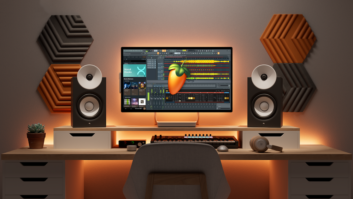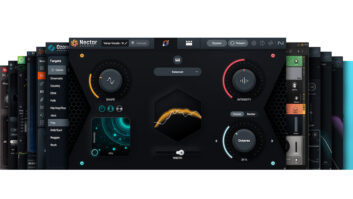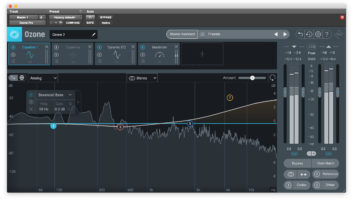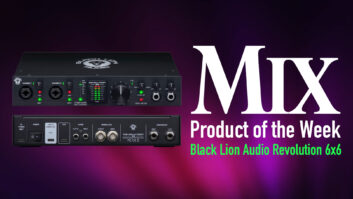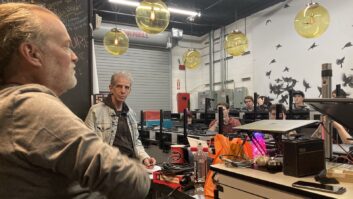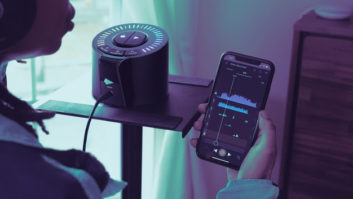In his Continuing Adventures In Software, Rich Tozzoli trades a swath of vocal processing for a single software tool.
I like reviewing a plug-in with no expectations or advanced info on it. It lets you go through the experience of trying it out with an open mind, and also, without the often-jaded opinions of colleagues. That’s just what happened when I recently got a copy of Izotope’s Nectar Complete Vocal Suite.
To begin with, I have always felt vocal mixing to be one of my weak spots. Personally, there is nothing harder to fit into a mix than a wildly dynamic vocal, especially when it’s surrounded by a busy track. Normally, I would turn to my old standbys of compression, EQ, verb and/or delay to make it happen. But with Nectar, they give you all these tools and more in one plug-in.
It delivers 11 vocal production effects, including compression, EQ, saturation, automatic pitch correction and a manual note editor, breath control, de-essing, a doubler, delay, reverb and gating. Nectar runs as RTAS/AS with Avid’s Pro Tools 7 or later, VST, MAS AU and Direct X on both Windows and Mac platforms. Authorization via iLok was simple, as was the quick installation process.
To start out, I called up a recent session with a good male vocalist where I used a nice hi-end mic and preamp. Opening up Nectar on an insert in Pro Tools, I was greeted by a bronze/orange brushed-metal look with a large EQ graph on the bottom, a handful of modules above that, a Preset Selection dropdown menu, and Input and Output Meters. There are also buttons for Reset, History, Options, Help, Advanced View, Presets and Bypass.
Without reading any manuals, I clicked through a few presets (available as Genre and Style), settling on one called Folk Reinforcement, since the vocals were over a nice acoustic guitar only. My first reaction was, “Holy s#)$*, this sounds really good!” I then played with the EQ a bit, which is simply dragging around any of the five EQ points onscreen. Next, I moved the De-Esser slider to pull down a few sibilant “esses,” slid up the Hype and Balance faders in the Body section, and turned the Preamp and Loudness up a bit in the Levels section. Hitting Bypass a few times, I was really floored! The results I got in about two minutes with this one plug-in would have taken me quite some time to achieve with several of my favorite tools.
Next, I hit the Advance View button and the screen turned into an arsenal of tools. Each module (Pitch, Breath Control, Gate, etc.) has its own set of parameters, available by simply clicking on your selection. So I chose Delay, adjusting the Mix, High Cutoff, Sync To Host and Tempo Sync settings. Easy breezy. Next, I put some light Reverb on (sounds quite nice, too), adjusted a little Compression and immediately saved my results as a preset.

I then went into Pitch Correction and figured out how to “capture the vocal.” A graphical editor allows you to manually correct the notes. You can even choose Undock Editor, which then opens a larger editor window, completely separate of the plug-in itself. I corrected a few small notes and then hit Dock Editor to reattach it. There are many more parameters on each module, and globally, than I can get into here. But it’s almost like, “if you think you need it, it’s probably in there”—and then some.
Nectar can run in two modes: Tracking and Mixing. Mixing mode has some latency on some of the modules, as it used look-ahead processing. In Tracking mode, it minimizes latency by not using lookahead functionality. I didn’t have a chance to track with it, but in mixing, the latency was not an issue, as I had Pro Tools using delay compensation. But it is nice to have a Tracking feature, easily turned on and off using the Mixing/ Tracking slider atop the meters.
Nectar is an excellent tool for anybody working with vocals, be it in music, voiceovers, narration or whatever. This thing couldn’t be easier to use, and the results speak for themselves. You can dial in quick results, or go deep into the menus to tweak. As of now, vocal production is no longer one of my weak spots.
